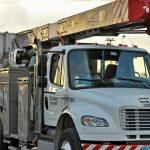How Thundersnow Can be Triggered by Wind Turbines

Image courtesy of Christian Collins under Attribution-ShareAlike 2.0 Generic License, resized to 700 x 391 pixels.
Thundersnow is a relatively uncommon weather event that results in lightning occurring within a snowstorm. This phenomenon has only recently been discovered, and as such, there is still much to learn about this unique weather event. That said, research is ongoing, and one recent finding is that wind turbines can actually trigger thundersnow.
How a Wind Turbine Can Trigger Thundersnow
In November 2022, a lake-effect snowstorm buried some areas near Buffalo, NY with over 6 feet of snow, and local residents were treated to multiple occurrences of thundersnow. Although a snowstorm of this magnitude was certainly not welcomed with open arms, it did provide a massive amount of data to study.
Scientists at State University of New York at Oswego (SUNY Oswego) pored through the data from the November 2022 event. They focused on an area called the Tug Hill Plateau, which experienced dozens of lightning flashes during the massive snowstorm and is also home to a 195-turbine wind farm (Maple Ridge Wind Farm). The plateau also houses a 16-sensor lightning mapping array (LMA) designed to monitor lightning frequency, severity, and other patterns.
According to the lead SUNY Oswego scientist, the LMA provided a three-dimensional portrait of each lightning flash, and the November 2022 storm provided the first opportunity to observe these images within the framework of a snowstorm.
The result is that a clear correlation was detected between the wind farm and the thundersnow event. What is still not understood is why this correlation exists, although an obvious part of the explanation is that wind turbines are tall structures. Because of this, they are susceptible to getting stuck by lightning. But interestingly, taller turbines appear more likely to also trigger upward-propagating lightning flashes that extend from the turbine into the storm.
No matter what the final study reveals, one thing is for sure – this research is important for any utility that operates wind turbines or wind power plants. It’s intuitively obvious that a tall structure like a wind turbine is prone to getting struck by lightning, which can take it offline and dampen reliability. But now, it’s likely that turbines have some role to play in actually creating lightning in the first place, at least as it relates to thundersnow. For this reason, the results of the SUNY Oswego will definitely be worth keeping an eye out for.



